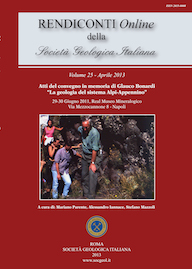
Evoluzione tettono-sedimentaria del Complesso d’Accrezione Liguride in Appennino Meridionale
Stefano Vitale (*), Sabatino Ciarcia (*), Alessandro Iannace (*), Stefano Mazzoli (*), Francesco D’Assisi Tramparulo (*) & Mohamed Najib Zaghloul (°)
(*) Dipartimento di Scienze della Terra, Università di Napoli Federico II, Largo San Marcellino 10, 80138, Napoli, Italia. E-mail: stefano.vitale@unina.it
(°) Department of Earth Science, Faculty of Sciences and Technique, University Abdel Malek Essaadi, Postal Box 416, 90000 Tangier, Morocco.
Volume: 25/2013
Pages: 116-136
Abstract
Tectono-sedimentary evolution of the Ligurian Accretionary Complex in the southern Apennines.
Aim of this paper is the structural and stratigraphic analyses of the Ligurian Accretionary Complex exposed in the Campania region (Italy) in order to unraveling the deformation pattern characterizing the transition from the final oceanic subduction stages to the early stages of deformation of the foreland continental margin. Our results outline a sequence of late Early Miocene (Burdigalian) shortening events, also involving buttressing of the accretionary wedge against the crustal ramp of the foreland continental margin. Emplacement of the overthickened accretionary complex onto the distal part of the continental margin was followed by horizontal extension and wedge thinning, aiding the development of wedge-top depocenters. Early Miocene NW-SE shortening recorded by Ligurian Accretionary Complex units is completely unrelated with later (Late Miocene to Pleistocene) NE-directed thrusting in the Apennines, which was coeval with back-arc extension in the Tyrrhenian Sea. Therefore, our results emphasize the occurrence of a major discontinuity in the Neogene geodynamic evolution of the southern Apennines, whose tectonic history may be clearly subdivided, from a kinematic point of view, into pre- and syn-Tyrrhenian back-arc extension stages.
Keywords
Get Full Text